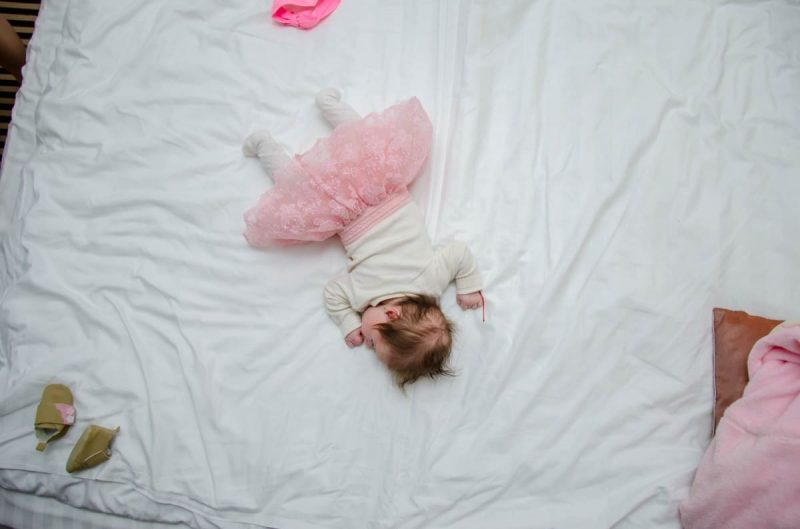Are you asking yourself for a perfectly sized bed for your lovely little one? Worry not! This article is for you to know how big is a baby mattress.
There are typically two types of baby mattresses: standard and mini.
Standard ones are 28 by 52 inches big, and minis are 24 by 38 inches small.
You will be deciding on the best for your baby, right?
So, without further ado, start scrolling down and enjoy reading!
How Big A Baby Mattress Is
Your baby will have to spend a significant amount of time on a comfortable mattress. Choosing how big is a baby mattress might be the best choice for you.
Here are the two types of baby mattresses commonly found in stores.
Standard size
This size is the most common and typical mattress size for baby mattresses.
The mattress should be no thicker than 6 inches.
It measures 28 inches wide and 52 inches long.
These types of mattresses are perfect for standard crib sizes.
If you need to know the sizes of cribs for your baby, it is best to go here.
Mini size
This kind of baby mattress comes in smaller sizes compared to standard sizes.
They are typically 24 inches wide and 38 inches long.
Make sure to take note of the different depths of baby mattresses, as these can affect the sleep comfort of your lovely baby.
What Are The Things To Remember In Choosing A Baby Mattress?
If you have the perfect size for your baby, you should know what to remember when choosing a baby mattress.
#1. Safety
Since safety is the greatest priority in choosing the best for your baby, the sizes of baby mattresses are regulated by law.
It aims to prevent accidental head entrapment and suffocation between the crib and the baby mattress.
Remember, even the mattress that you have both happens to fit inside the crib.
It would help if you were carefully using it unless it is a specified crib mattress.
You want to avoid any foam toppers or other non-regulated crib mattress cover.
This way is for the safety of your infant.
#2. Firmness
Firmer mattresses are better choices for babies compared to soft ones. Soft sleeping surfaces can have a suffocation hazard to your baby.
It may also increase the likelihood of certain diseases such as sudden infant death syndrome or SIDS.
A test on the firmness of the mattress is by pressing in its center and edges.
When the force is released, the mattress should snap back quickly.
#3. Non-toxic
You should take note that your baby will probably spend their early years on the mattress.
It would help if you went for a possibly organic mattress. Look for certification standards like Global Organic Textile Standard or GOTS.
So, making it safe and healthy is recommended for them.
It can also be certified by Global Organic Latex Standard or GOLS.
#4. Weight and depth
Some mattresses have deeper dimensions, although it does not contribute to their firmness.
Take note that coil-spring mattresses have a thicker dimension by 5 to 6 inches deep; whereas, foam mattresses are 4 to 6 inches deep.
Mattresses made from foam tend to be lighter, except ones that are made from memory foam.
#5. Length of use
Few mattresses are reversible, having a firm side for babies and slightly firm for toddlers.
They are named two-stage mattresses, which are typically marked which side to be used.
#6. Cost
A good quality baby mattress comes between the prices of 90 to 200 USD.
If you are eyeing organic and hypoallergenic ones, you may be spending more money.
#7. Covers
Most baby mattresses have covers to help protect the bed’s surface from diaper spills and other accidents.
If you want a good, reliable cover, go for safer water-proof, breathable, and hypoallergenic options.
Avoid covers that have plastic seams containing sharp edges. Also, observe fabric seams if they are not stretched or strained yet.
Dear parent, I recommend you to have two baby mattress covers; one dedicated for the crib and an extra one for accidents.
#8. Buy new
As much as possible, avoid dirty, abused, or used baby mattresses as they can have some dangers.
Molds can grow into old mattresses where they can cause diseases that are not good for your infant’s health.
You should buy newer ones to keep these hazards away.
#9. Consider border rods
If you have a baby mattress with innerspring features, make sure that it has border rods.
They typically go around the perimeter of the top and bottom of the mattress.
Border rods provide additional firmness, durability, and support.
The Bottom Line
Great! Now you know how big is a baby mattress.
They typically come in two sizes: mini and standard.
Mini ones are 24 inches wide and 34 inches long, while standard ones are 28 inches wide and 52 inches long.
It would be best if you also considered some things that are important before buying a mattress.
I hope this information answered your question.
Please share this with parents that you may know who are concerned about their baby mattresses.

